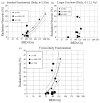Radiation dose-volume effects in the brain
- PMID: 20171513
- PMCID: PMC3554255
- DOI: 10.1016/j.ijrobp.2009.02.091
Radiation dose-volume effects in the brain
Abstract
We have reviewed the published data regarding radiotherapy (RT)-induced brain injury. Radiation necrosis appears a median of 1-2 years after RT; however, cognitive decline develops over many years. The incidence and severity is dose and volume dependent and can also be increased by chemotherapy, age, diabetes, and spatial factors. For fractionated RT with a fraction size of <2.5 Gy, an incidence of radiation necrosis of 5% and 10% is predicted to occur at a biologically effective dose of 120 Gy (range, 100-140) and 150 Gy (range, 140-170), respectively. For twice-daily fractionation, a steep increase in toxicity appears to occur when the biologically effective dose is >80 Gy. For large fraction sizes (>or=2.5 Gy), the incidence and severity of toxicity is unpredictable. For single fraction radiosurgery, a clear correlation has been demonstrated between the target size and the risk of adverse events. Substantial variation among different centers' reported outcomes have prevented us from making toxicity-risk predictions. Cognitive dysfunction in children is largely seen for whole brain doses of >or=18 Gy. No substantial evidence has shown that RT induces irreversible cognitive decline in adults within 4 years of RT.
Copyright 2010 Elsevier Inc. All rights reserved.
Conflict of interest statement
Conflict of interest: none.
Figures


Similar articles
-
Congress of Neurological Surgeons Systematic Review and Evidence-Based Guidelines on the Role of Whole Brain Radiation Therapy in Adults With Newly Diagnosed Metastatic Brain Tumors.Neurosurgery. 2019 Mar 1;84(3):E159-E162. doi: 10.1093/neuros/nyy541. Neurosurgery. 2019. PMID: 30629211
-
Single-fraction radiosurgery versus fractionated stereotactic radiotherapy in patients with brain metastases: a comparative study.Clin Exp Metastasis. 2020 Jun;37(3):425-434. doi: 10.1007/s10585-020-10031-5. Epub 2020 Mar 17. Clin Exp Metastasis. 2020. PMID: 32185576
-
Biological implications of whole-brain radiotherapy versus stereotactic radiosurgery of multiple brain metastases.J Neurosurg. 2014 Dec;121 Suppl:60-8. doi: 10.3171/2014.7.GKS141229. J Neurosurg. 2014. PMID: 25434938
-
Major complications from radiotherapy following treatment for atypical meningiomas.Neurosurg Focus. 2019 Jun 1;46(6):E5. doi: 10.3171/2019.3.FOCUS1930. Neurosurg Focus. 2019. PMID: 31153147
-
Tumor Control Probability of Radiosurgery and Fractionated Stereotactic Radiosurgery for Brain Metastases.Int J Radiat Oncol Biol Phys. 2021 May 1;110(1):53-67. doi: 10.1016/j.ijrobp.2020.10.034. Epub 2020 Dec 31. Int J Radiat Oncol Biol Phys. 2021. PMID: 33390244 Review.
Cited by
-
Asymptomatic Evolution and Regression of Temporal Lobe Necrosis After Adjuvant Radiation for Skin Cancer: A Case Report and Review of Literature.Cureus. 2016 Feb 5;8(2):e481. doi: 10.7759/cureus.481. Cureus. 2016. PMID: 27226935 Free PMC article.
-
The evolving roles and controversies of radiotherapy in the treatment of glioblastoma.J Med Radiat Sci. 2016 Jun;63(2):114-23. doi: 10.1002/jmrs.149. Epub 2016 Jan 21. J Med Radiat Sci. 2016. PMID: 27350891 Free PMC article. Review.
-
Whole brain radiation therapy resulting in radionecrosis: a possible link with radiosensitising chemoimmunotherapy.BMJ Case Rep. 2023 Nov 28;16(11):e256758. doi: 10.1136/bcr-2023-256758. BMJ Case Rep. 2023. PMID: 38016763
-
Analysis of dosimetric factors associated with temporal lobe necrosis (TLN) in patients with nasopharyngeal carcinoma (NPC) after intensity modulated radiotherapy.Radiat Oncol. 2013 Jan 22;8:17. doi: 10.1186/1748-717X-8-17. Radiat Oncol. 2013. PMID: 23336282 Free PMC article.
-
Significance of target location relative to the depth from the brain surface and high-dose irradiated volume in the development of brain radionecrosis after micromultileaf collimator-based stereotactic radiosurgery for brain metastases.J Neurooncol. 2012 May;108(1):201-9. doi: 10.1007/s11060-012-0834-3. Epub 2012 Mar 6. J Neurooncol. 2012. PMID: 22392126
References
-
- Lax I, Karlsson B. Prediction of complications in gamma knife radiosurgery of arteriovenous malformation. Acta Oncol. 1996;35:49–55. - PubMed
-
- Voges J, Treuer H, Sturm V, et al. Risk analysis of linear accelerator radiosurgery. Int J Radiat Oncol Biol Phys. 1996;36:1055–1063. - PubMed
-
- Flickinger JC, Kondziolka D, Pollock BE, et al. Complications from arteriovenous malformation radiosurgery: Multivariate analysis and risk modeling. Int J Radiat Oncol Biol Phys. 1997;38:485–490. - PubMed
-
- Miyawaki L, Dowd C, Wara W, et al. Five year results of LINAC radiosurgery for arteriovenous malformations: Outcome for large AVMS. Int J Radiat Oncol Biol Phys. 1999;44:1089–1106. - PubMed
-
- Chin LS, Ma L, DiBiase S. Radiation necrosis following gamma knife surgery: A case-controlled comparison of treatment parameters and long-term clinical follow up. J Neurosurg. 2001;94:899–904. - PubMed
Publication types
MeSH terms
Grants and funding
LinkOut - more resources
Full Text Sources
Other Literature Sources

